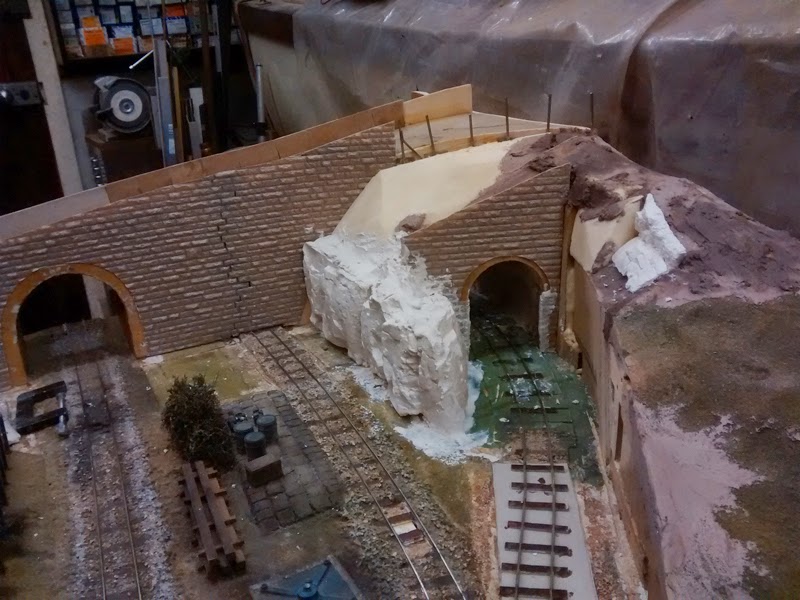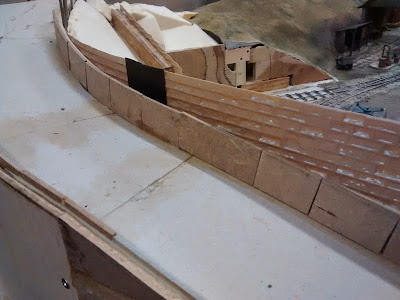Worklist:
Develop tunnel mouth.
Develop retaining wall.
Develop roadway and side wall/fence.
Glue the cardboard road down.
Develop bridge cladding.
Repair tunnel track and install magnet.
A congested three weeks that saw us miss one and shift the following two meetings to Wednesdays. We're also trialling an early start to allow S&L to beat the homeward traffic better.
On arrival, Geoff announced that he'd found a problem with the first section of track going into the tunnel - a 'ski-slope' of a joint. The obvious answer was to cut it out and form it correctly. As he started, it dawned on us that it was also the section we were planning to add another magnet to allow shunting allied to the mine siding. Doing it with the track removed was infinitely easier than with it in place, so a 'stroke of luck'. The magnet hole was marked out and corner pilot holes drilled. Two small holes marking the centreline of the track were also drilled, to assist locating the magnet from underneath.
Geoff used his oscillating saw to cut the hole, then continued to form the new section of track.
The remnants of the old tunnel mouth retaining wall can be seen above (Pyruma facing removed), beside the new retaining wall base. We hadn't given the old wall much thought, assuming it would be reinstated with DAS stonework or similar. However, Stephen had prepared a sample of the timber sleeper wall we were considering and we immediately decided to extend it right down to ground level. This required the old ply base to be removed and a new base installed, continuing the new section. A bit of wall reshaping was also possible to ease a tight spot.
The new timber wall (temporarily on masking tape) was offered into place. Plastic RSJ beam section and some 'chunky' bolt head details were purchased at ExpoNG at Swanley the previous week. These will represent 'ground anchor spreader beams' across the front of the sleepers. The sleepers are 5mm balsawood, in 12 ft lengths, stained Peruvian Mahogany.
In the photos above and below can be seen the results three other tasks. The roadway side wall has been cut away on the inside. This lessens the bulk of the bridge stonework and adds a bit of interest. The outside wall will change from bridge stone to dry stone wall. We pressed Laurence into action, making the rail fence posts. The tunnel mouth parapet has been increased in height. We're not sure of the final arrangement of the rocks/ground over the tunnel, but this seemed like a good idea.
Also at Swanley, we spotted some Slaters 7mm stone walling very effectively used on a large industrial layout, and purchased some. Our final task was to offer this up and work out how to form the bridge mouth edging and join the next sheet. We decided to cut whole stones away around the opening and infill with DAS scribed accordingly. This can extend into the opening. Some plastic brickwork sheet will line the inside of the bridge.
We've not used this sheet before, and aren't sure how to join two sheets. However, it is coursed, so we marked out whole stones along the edge, and will cut the part-stones out. We hope that doing the same on the next sheet, will allow us to use DAS to infill between the two.
Stephen glued the cardboard road bed down and in-filled the gaps in the parapet walls. John had used liberal amounts of Pyruma on the bridge walls, but the plywood alone now look a bit thin. If they are covered with 'plastic stonework, they might need thickening with an overlay, beforehand. However, a DAS wall finish might achieve the desired thickness. We'll have to see....
As usual, we spent a little while taking in what we'd achieved. It's always a pleasant relief when we realise that the layout has moved along and still remains a believable entity!





























